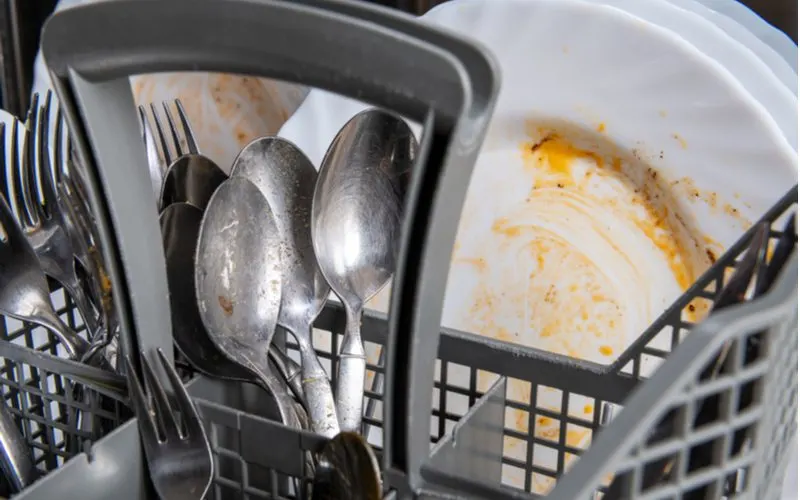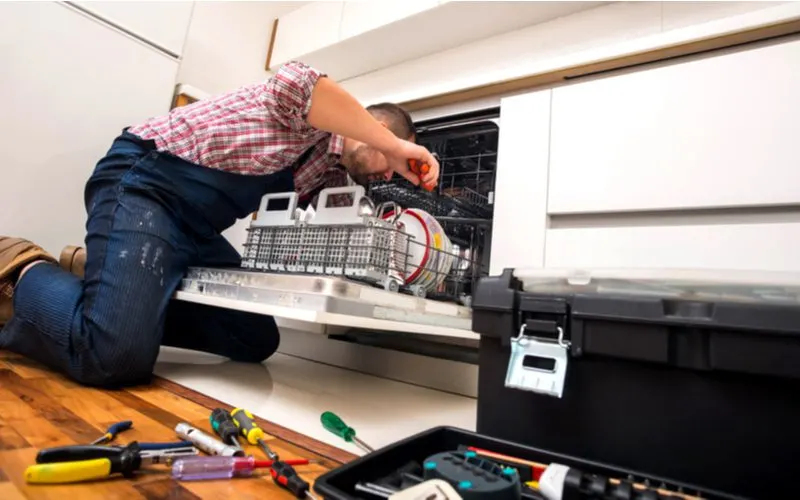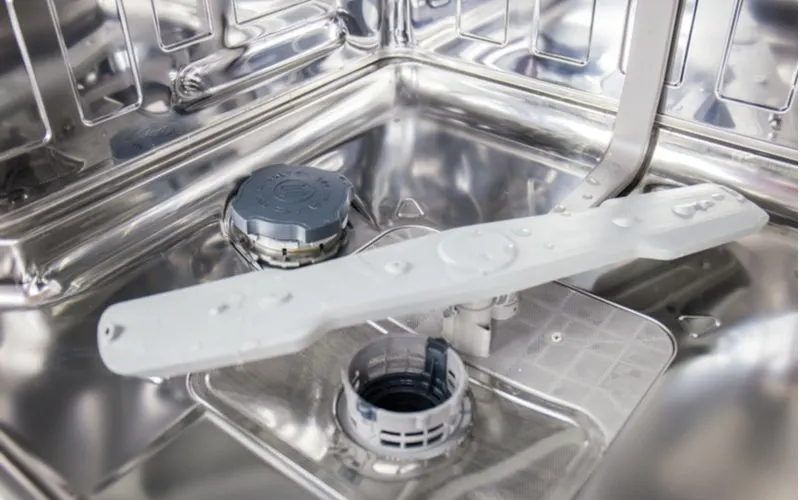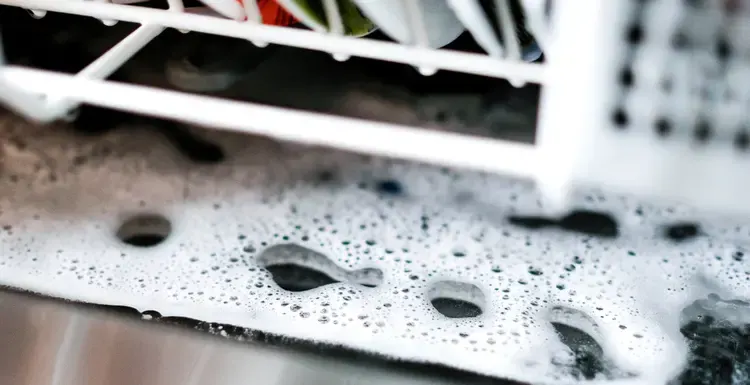Dishwashers are one of the best timesavers in the kitchen.
They work really well and are a great invention if they’re used correctly. However, right when most people rely on their dishwasher, a disaster can happen suddenly, and a problem occurs.
When a dishwasher doesn’t drain, it’s a problem. But don’t worry—it could be a quick and easy fix you can do yourself. Fortunately for you, we’ve rounded each of these fixes up into the guide below.
We partnered with Networx to help you find local plumbers in your area. Click to below to get a FREE quote.
Dishwasher Won’t Drain? Don’t Worry

Gabi Moisa/Shutterstock
The first dishwashers invented required more work than they saved. Nowadays, dishwashers are a standard in almost any kitchen, and the products used with them are reliable.
They get the job done with minimal effort, saving lots of time, effort, and energy for those in and around the kitchen.
If your dishwasher won’t drain, the first instinct is to call a plumber. No, you don’t need to shell out cash for a plumber or buy a new dishwasher.
You can try a few things, like running dishwater again, checking the hoses, and looking for air gaps yourself, before you spend your holiday savings on a technician to pay you a visit. We’ll explain each of these in a second.
Fixing a Dishwasher That Won’t Drain
There are a number of options to explore that might resolve the issue quickly and effectively without having to open the wallet. Anyone can try these, and they don’t require any special tools or intricate knowledge.
1. Run the Dishwasher Again
It might be that the cycle hasn’t finished. If you turn it off by mistake, water will accumulate in the bottom, and giving it another cycle could get rid of the problem.
2. Check the Hoses
Take a look at the hose that drains the water from the dishwasher and pours it into the garbage disposal drain. You need to check that there is no unground food or garbage in it.
This might be keeping the dishwasher from draining properly. You can also try running the disposal unit a couple of times for it to clear and thus enable the dishwasher to empty properly.
3. Look for Air Gaps
Another thing that could be keeping the dishwasher from draining properly is that if there’s no garbage disposal in the sink, there will be an air gap element installed on your sink next to the faucet.
There is a tiny hose that connects this element, called an air gap which is normally made of stainless steel, to the draining hose of the dishwasher.
The air gap serves as a vent to keep an air block from being created in the hose that drains water from the machine, and with time, this device can get clogged with waste products.
Remove this air gap by twisting it, then clean it with water and soap, put it back into place, and run the dishwasher again to see if the problem has been solved.
4. Drain the Water Manually
If you don’t have a disposal for debris in your sink, then you will have to drain the dishwasher.
To do this, you will need to use rags or absorbent paper towels by placing them at the bottom of the dishwasher. Then remove the bottom tray of the dishwasher, which is done by sliding it out of the machine.
Next, use something like a plastic container or a cup and remove the water from the dishwasher. These machines nowadays are designed to work with specific products that don’t create suds.
However, if you ran out of dishwashing products and used normal dishwashing soap in the dishwasher to save time, then the problem with the machine could be that the soap has created so much foam and suds that it has blocked the draining pipe.
If detergent was added, the situation would be the same.
in this case, remove the water from the bottom of the dishwasher and then run the machine again but using the right kind of dishwashing liquid it was designed to use, and then once the cycle has been completed, the device should drain properly.
5. Check the Drain Basket
Another thing that could be keeping your dishwasher from draining water completely is the drain basket getting clogged up with debris from the dishes you put in the machine.
This part of your dishwasher is located inside the dishwasher at the bottom, and it has a cover that is similar to a little basket. It’s held in place by pressure or by a screw.
You can check this element if you can’t find it by googling the user manual of your particular dishwasher if you don’t have a paper manual.
Remove this part and clean out the basket using your hand, a spatula, or something similar to a spoon. Put the cover back into place, turn on the dishwasher again, and let it operate for a full cycle.
Keeping Your Dishwasher Running

Mhp/Shutterstock
It’s a good idea to rinse the dishes and cooking elements you use before putting them inside the dishwasher to keep the drain basket from getting clogged up with debris.
Today’s dishwashers come with macerators that reduce the food particles that are present on the dishes and pots and pans you place in the dishwasher; however, this part of the machine is not as strong as a garbage disposal grinder.
This is why it’s always a good idea to rinse dishes before placing them inside the machine, even if your dishwasher says you don’t need to.
The drain hose might be the problem. This element is a hose that goes from the drain pump of the dishwasher to the garbage disposal unit in the sink or the air cap.
If there is a kink in this hose, it could be keeping water from draining properly. Check under the sink where the hose is to see if anything is creating an obstacle and kinking the hose.
You might have to replace this hose if it has a kink because normally, this type of lightweight ribbed plastic hose will develop a bend in the same place once it has been straightened and will need replacement.
Things to Consider

Gorgev/Shutterstock
Unplug the Dishwasher
Before you touch anything or do anything at all with the machine, unplug it from the electricity!
You should never handle kitchen appliances or disassemble them while they’re plugged in. So, unplug it before you remove the front panel, which might be a snap-on type or has a couple of screws.
Check the Hose
Check your user manual if you don’t know how to disconnect the hose. Once you have disconnected the hose, blow through it. If you can’t, then there is a block somewhere in it.
If the plug is at either end of the hose, use something long and thin like a screwdriver or a straight piece of wire such as a wire hanger to clear it.
If this doesn’t work, try removing it at the other end to check if there is a clog at the part that joins with the garbage disposal of the sink or the air cap. If the clog is in the middle section of the drain hose, you might have to replace this element.
Replace the Drain Hose
By now, you will be running out of options, but before you call in the plumber who will charge you for a home visit, you can try to replace the drain hose. In order to do this, you will have to remove the dishwasher from under the counter.
After, disconnect the hose from the pump and the garbage disposal unit or the air gap if you don’t have a garbage disposal element in your sink. Attach the new hose, and you are set to go!
Check the user manual to make sure you have purchased the exact same model that you are trying to replace, as well as for instructions about how to replace this part.
Call a Plumber
If you have done all of the above and the machine is still not working, the problem could be found in the pump or the motherboard and timer of the dishwasher.
Fixing these elements can only be done by a licensed technician, so you will need to call a plumber if none of these have worked.
However, you will have eliminated all the potential problems, and the plumber might charge you fewer man-hours for working on your dishwasher.
Most dishwashers come with parts that the owner, with minimal aid from the owner’s manual, can handle. Don’t be afraid to try fixing it yourself by checking all the parts because it has been designed to be checked by a user.
You will need to call in a plumber if the machine has been working with difficulty for some time before it develops the symptom of water in the pan at the bottom.
We partnered with Networx to help you find local plumbers in your area. Click to below to get a FREE quote.
Replace the Dishwasher
Another thing that can be at fault is that if the dishwasher is old, then it might have become obsolete.
Fixing one part might lead to another part breaking down with the machine becoming unusable, and then you need a plumbing expert because normal attempts to unblock it or clear it have not worked.
You also might have to invest in a new dishwasher if the problem lies in the pump or the electrical parts of the dishwasher, and this needs to be seen by an expert.
However, it’s still a good idea to go through all these steps because if, in the end, you call a plumber, it will be because the problem is not easy to solve.
There is nothing worse than shelling out $150 bucks to a plumber to fix something that takes ten minutes to resolve.
As a consumer, you can use the same tricks the plumber used and save yourself a considerable sum of money, and only spend this cash if the problem is a really hard one that you couldn’t solve anyway.
Another thing to watch out for is the warranty of the dishwasher. If you are still in the warranty period, then calling an expert from your dishwashing manufacturing company will be free of charge.
Always check the validity date of your dishwasher before calling an expert that is not from the brand that you have. The unauthorized manipulation of the device will void your guarantee and cost you quite a bit.
Frequently Asked Questions

Happy Lenses/Shutterstock
How to get rid of standing water in a dishwasher?
Have standing water in your dishwasher? Mix a cup of baking soda with a cup of vinegar and pour it into the standing water in the dishwasher.
Leave for 20 minutes; if there is no movement of the water, start looking for the issue.
Should I run my dishwasher if it has standing water?
If you have cleared the screen and the drain trap and the water still won't drain, begin checking for another issue. Running the dishwasher at this point will only cause a bigger mess.
Can I use a household drain cleaner in a dishwasher?
Products meant to clear sink and shower drains are not recommended for use in dishwashers. The products can damage the machine's pump, causing bigger problems.
Cleaning Your Dishwasher Drain Without Help
It’s very possible to fix a draining problem in a dishwasher without calling in an expert. Generally, the problem is relatively minor and will be easily rectified.
As long as the issue is not in the pump, the draining process utilizes few mechanical parts, making the job of fixing a drain problem fairly simple to address.


